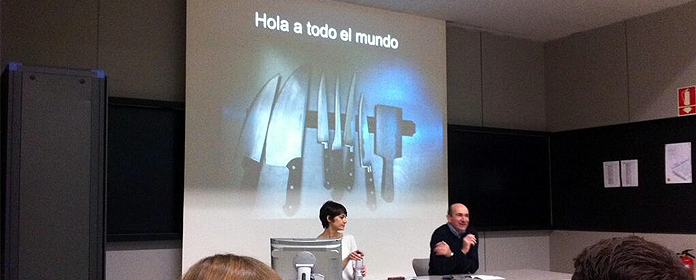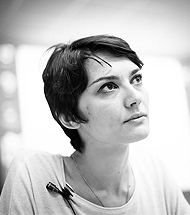"Never lose your capacity for wonder."
Guadalupe de la Vallina, better known as @Lupe_ on Twitter, has shared her experiences as a photographer with 4th year Journalism students.


Lupe, in order to make the characters she portrays feel comfortable, plays music whenever she can. A list of jazz tunes playing through the speakers so that the protagonists she focuses on with her camera can relax and let go. The chronicle of the class that he gave this Thursday at School Communication, therefore, also has a soundtrack (at the end of the news). With a "Hello everyone" printed on the first photograph that has projected, the choice is clear then. Although it is not easy to put music to this artist who, among her facets, is a singer. Even more so, when the presentation of today's protagonist has started with Professor Javier Marrodán quoting the importance of silence.
The sound detail is just one of the many clues that Guadalupe de la Vallina has offered to the students of the 3rd year of journalism. Better known as Lupe (or @Lupe_), this graduate in Audiovisual Communication from the Francisco de Vitoria University, photographer -especially portrait photographer, where she has assured that she feels more comfortable- , 30 years old, wife, ninja mother of a boy of almost 2, editor, art lover, hardened in desk jobs that made her see what she did not want to dedicate herself to... has put herself under the spotlight to share her experiences with the students. "The photos I like to take most are of people who don't hide their pain or their flaws," she has confessed. And, applying her own criteria, she has allowed the students to "come in" to meet Lupe, insistently encouraging them, during the nearly 2 hours of class, to ask questions.
The backbone of the session was her work, organized in three specific examples of the digital magazine Jotdown, for which she has been working for two years:"A walk through the Thyssen";"Dominican Republic: where is the money?" and the portraits of interviews with figures such as Enrique Meneses, Juan José Millás, Xabi Alonso, Leonor Watling, Ángeles González-Sinde... Without complexes, she began by saying that she came to Jotdown thanks to a comment she made on one of her photographs. They "reciprocated" by visiting her Flickr and that's how she was asked to work for the publication. She accepted, "with a poker face, not saying anything until they realized she wasn't a professional photographer". And so today, two years later, she is one of the members of the successful magazine. In each of the interviews, he said, he takes almost 700 photos, of which 100 are worth, chooses the 30 he likes the most and sends them, even though maybe 5 are published later. Among the arguments for choosing, for example, that the person portrayed should not be talking, that they should be gesticulating, that they should sit on a chair rather than on an armchair... and a core topic idea: that whoever sees the photograph should feel close, that they even end up liking the protagonist. When it comes to choosing, what method do you use? Curiosity. The ability to be amazed, which Lupe has appealed to time and time again.

